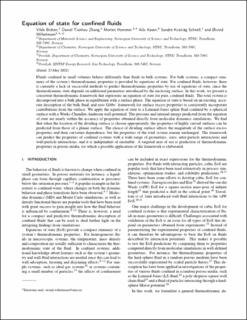| dc.contributor.author | Bråten, Vilde | |
| dc.contributor.author | Zhang, Daniel Tianhou | |
| dc.contributor.author | Hammer, Morten | |
| dc.contributor.author | Aasen, Ailo | |
| dc.contributor.author | Schnell, Sondre Kvalvåg | |
| dc.contributor.author | Wilhelmsen, Øivind | |
| dc.date.accessioned | 2022-12-16T09:48:48Z | |
| dc.date.available | 2022-12-16T09:48:48Z | |
| dc.date.created | 2022-07-19T08:55:37Z | |
| dc.date.issued | 2022 | |
| dc.identifier.citation | Journal of Chemical Physics. 2022, 156 (24), . | en_US |
| dc.identifier.issn | 0021-9606 | |
| dc.identifier.uri | https://hdl.handle.net/11250/3038211 | |
| dc.description.abstract | Fluids confined in small volumes behave differently than fluids in bulk systems. For bulk systems, a compact summary of the system's thermodynamic properties is provided by equations of state. However, there is currently a lack of successful methods to predict the thermodynamic properties of confined fluids by use of equations of state, since their thermodynamic state depends on additional parameters introduced by the enclosing surface. In this work, we present a consistent thermodynamic framework that represents an equation of state for pure, confined fluids. The total system is decomposed into a bulk phase in equilibrium with a surface phase. The equation of state is based on an existing, accurate description of the bulk fluid and uses Gibbs' framework for surface excess properties to consistently incorporate contributions from the surface. We apply the equation of state to a Lennard-Jones spline fluid confined by a spherical surface with a Weeks-Chandler-Andersen wall-potential. The pressure and internal energy predicted from the equation of state are in good agreement with the properties obtained directly from molecular dynamics simulations. We find that when the location of the dividing surface is chosen appropriately, the properties of highly curved surfaces can be predicted from those of a planar surface. The choice of the dividing surface affects the magnitude of the surface excess properties and its curvature dependence, but the properties of the total system remain unchanged. The framework can predict the properties of confined systems with a wide range of geometries, sizes, interparticle interactions, and wall-particle interactions, and it is independent of ensemble. A targeted area of use is the prediction of thermodynamic properties in porous media, for which a possible application of the framework is elaborated. | en_US |
| dc.description.abstract | Equation of state for confined fluids | en_US |
| dc.language.iso | eng | en_US |
| dc.publisher | AIP Publishing | en_US |
| dc.title | Equation of state for confined fluids | en_US |
| dc.title.alternative | Equation of state for confined fluids | en_US |
| dc.type | Peer reviewed | en_US |
| dc.type | Journal article | en_US |
| dc.description.version | acceptedVersion | en_US |
| dc.source.pagenumber | 16 | en_US |
| dc.source.volume | 156 | en_US |
| dc.source.journal | Journal of Chemical Physics | en_US |
| dc.source.issue | 24 | en_US |
| dc.identifier.doi | 10.1063/5.0096875 | |
| dc.identifier.cristin | 2038727 | |
| dc.relation.project | Norges forskningsråd: 275754 | en_US |
| dc.relation.project | Norges forskningsråd: 262644 | en_US |
| dc.relation.project | Sigma2: NN9414k | en_US |
| cristin.ispublished | true | |
| cristin.fulltext | postprint | |
| cristin.qualitycode | 1 | |
